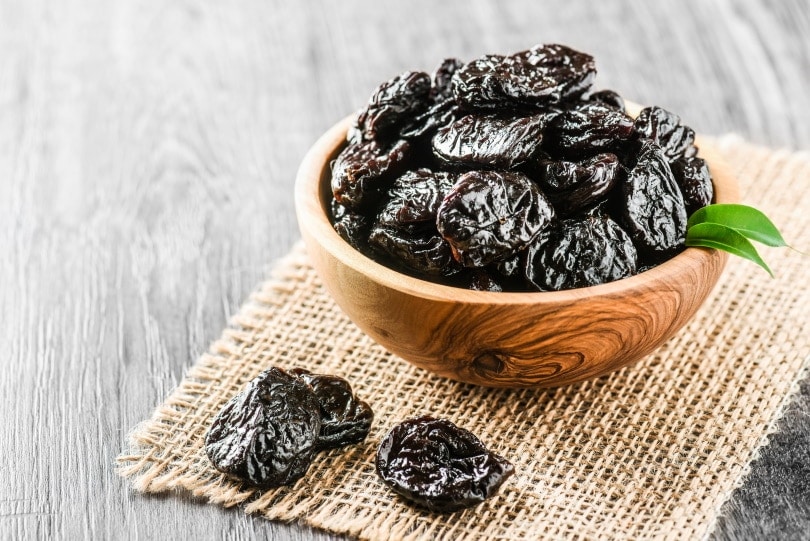Can Dogs Eat Plums? Vet-Approved Facts & Safety Guide
Updated on

Dogs can enjoy munching on a variety of different fruits and vegetables that are tasty and good for them. Foods like bananas, apples, and broccoli are all great options. However, not all fruits and veggies are great for dogs to get their paws on. One example is the plum. While it likely won’t cause your dog any harm if they eat a bite or two of plum flesh, there are a few reasons that you shouldn’t offer plums to the dogs regularly. If you are thinking of offering your dog any human food as a treat, you should first consult with your vet. Also, you should never let your dog have an entire plum with its pit. Here’s what you should know.
Why Your Dog Should Not Regularly Eat Plums
An occasional snack of plum flesh can provide your dog with a bit of extra fiber and antioxidants. However, dogs should receive all the nutrients they need from eating their regular high-quality diet, and they do not require any additional foods.
Plums are rich in sugar and fiber, and eating too many can cause digestive signs, such as vomiting and diarrhea. It can also have a negative effect on blood sugar levels if your dog is diabetic. So, if you have a healthy adult dog and you decide to offer any plums to your dog, only give them a tiny portion of the flesh, and only as a very occasional snack. Never allow your dog to chew on or eat a plum pit!

Why Your Dog Should Never Have Access to Plum Pits
There are a few serious problems that plum pits can pose to canines, so they should be kept away from your dog at all costs. Plum pits are large and have sharp edges. At a minimum, they can cause serious gastrointestinal irritation. At worst, the pit can pose a foreign body hazard and cause an intestinal blockage.
An intestinal obstruction can be deadly. You should contact your vet if you are worried about your dog eating a plum pit, especially if they are a toy or a small breed. Worrying signs include lack of appetite, drooling, vomiting, lethargy, and/or diarrhea. If your dog develops any of these signs, you should get them to your veterinarian as soon as possible. Also, plum pits contain cyanide. Luckily, one pit does not contain enough cyanide to cause any serious harm, but if you have plum trees in the yard, you might need to worry about your dog eating too many whole plums.
Why You Should Keep Plum Leaves and Stems Away From Your Dog
Plum leaves and stems contain cyanide, like the pits do. If your dog consumes these plant parts in large amounts, it can cause serious toxic signs such as dilated pupils, bright red gums, difficulty breathing, panting, and even shock. For this reason, make sure the leaves and stems that you pull off of plums when preparing them to be eaten are always discarded in a place where your dog cannot access them.
Can Dogs Eat Prunes?

Prunes are dehydrated plums that are known to help humans improve their digestion. They are technically fine for dogs to eat. However, these dried fruits have even more sugar in proportion than fresh plums, so they should not be made a regular part of any dog’s diet. Also, prunes tend to be sticky, and they can get stuck in your dog’s teeth. This can be uncomfortable and contribute to problems like gum disease.
What to Do if Your Dog Eats a Whole Plum or Prune
If your dog eats an entire prune, there probably won’t be any issues. At most, your dog might get a bit of digestive upset due to the sugar and fiber. The same goes if your dog eats the flesh of a whole plum. Just keep an eye on them for any signs of gastrointestinal issues. However, if your dog eats an entire plum, pit and all, you must call your veterinarian to let them know about the situation. They may tell you to keep a close eye on them for signs of poisoning and intestinal obstruction for the next few days.
If you notice that your dog starts to look ill in any way, gets lethargic, doesn’t have the same interest in walks or games as they usually do, vomits after eating, loses their appetite, or sways when they walk, get them to an emergency veterinarian right away, as poisoning and/or obstruction is likely the cause of the distress.

In Conclusion
Offering your dog a bite or two of a fresh plum or a prune once in a while should not cause any problems. Plum flesh can be refreshing on a hot summer day. It’s when they are eating plums regularly or if they swallow a pit, stems, or leaves that you should be concerned. Keep in mind that, if in doubt, your best call is to contact your vet to have a professional opinion on your dog’s health.
- Related Read: Can Dogs Eat Apricots? Nutrition Facts & Safety Guide
Featured Image Credit: Left (Dog) Pexels, Pixabay; Right (Plums) NoName_13, Pixabay











